http://www.doctorhousingbubble.com/california-housing-history-move-up-buyer-riskless-interest-rate-delusion-culver-city-housing-and-income/
California is an odd sort of duck when it comes to the housing market. The market has dramatically collapsed in the Inland Empire and Central Valley with very little news coverage and many of these areas run similarities closer to what we are seeing in Las Vegas and Arizona.
Take for example Riverside County. Home prices peaked in June of 2006 with the median home price selling for $422,000. Today the median price is $200,000 down a jaw dropping 52 percent from the peak.
Let us now take Orange County. Orange County peaked in August of 2007 with a median price of $642,250 and today the median price is $445,000, a drop of 30 percent.
The argument I have made for California housing is not that every area is in a bubble (this was a case at the peak) but many specific markets still carry inflated values today in the summer of 2011. The only reason these prices remain this way is because of lax lending, Federal Reserve intervention, and banks holding large amounts of homes in what is known as the shadow inventory. We hear rumblings about the soon to expire conforming loan limits. This expiration will have little impact on say the county of Riverside but will be a significant change to Orange County. Let examine what a more “normal” market would look like.
Don’t get used to mortgage rates being this low
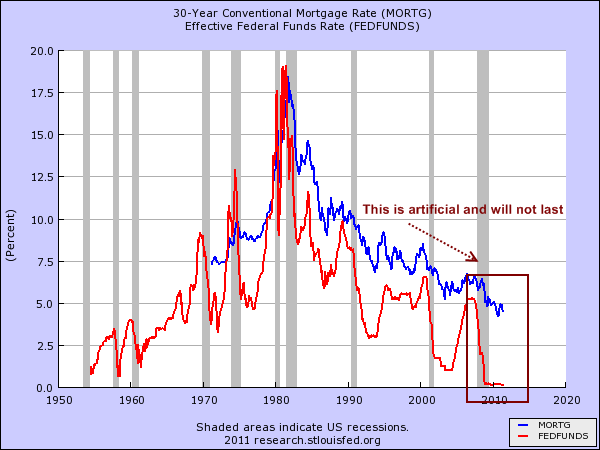
For over forty years the average 30 year fixed rate mortgage carried an interest rate of approximately 8 percent. Today that rate is down below 5 percent. There is only one reason for this; the Federal Reserve has bought trillions of dollars in mortgage backed securities shunned by the market and the global meltdown. There is an incredible underpricing of risk going on right now. The U.S. is still a flight to safety harbor but for how long given how our banks and politicians run things? The above chart reflects an unsustainable housing system for the United States. Mortgage rates are at rock bottom levels. I hear the argument going like, “rates have never been this low so you should buy!” Of course when home prices were going up it was, “don’t be priced out of the market!” Yet this mentality will only work if you think rates will remain low for a very long duration of time moving forward. Because what many potential California buyers will not tell you is that they are only buying their home as a starter home. There is no desire to stay put for 30 years. The name of the game is buy, build bubble equity, sell, and move into another bigger inflated place. Of course this model has severely imploded but the psychology is painfully resistant to adjust lower. Call it the Duesenberry demonstration effect.
First, let us run a scenario on a $549,000 home:
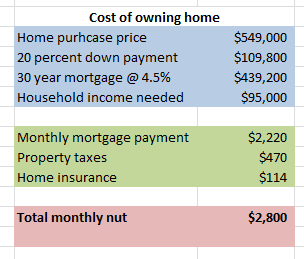
Many “starter” homes in places like Culver City will still cost this amount which is still insane. First, we will go with a 20 percent down payment of $109,800. This is only covering the down payment and not the additional closing costs to close out escrow but let us keep this simple. You would be financing a mortgage four times the size of a household income that would qualify for this property. You can buy a home at this price point if your household income pulls in $95,000. First, that income does not support a $549,000 home adequately and provides little buffer for mistakes but these are the kinds of transactions taking place today. After we factor in the monthly payment, $2,800 is coming out to pay your housing expenses each month. Now how much is a household making $95,000 a year taking in per month?
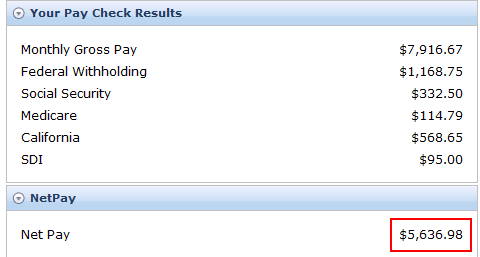
So basically for a starter home 50 percent of net pay is going to pay for housing expenses. This is insanity but you can actually qualify for this loan today if you went for it. But let us make a simple rational assumption. What if mortgage rates track back up to their historical four decade average? Let us run those numbers:
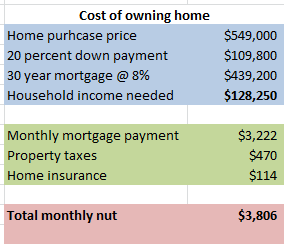
Now, you will notice that a household will magically need $30,000 more a year just to qualify. Plus, the monthly home payment jumps by $1,000 to $3,806. This is why the Federal Reserve is doing everything it can to keep mortgage rates artificially low even if it means imploding our economy with debt only a few years down the road. You have to ask why doesn’t the government just focus on increasing incomes since this will clearly push home values higher? After all, if the government is working with banks to artificially keep home prices up why not aim at artificially inflating incomes? Well first, the system is setup to hide shadow inventory and allow banks to push maximum leverage onto buyers and move them into over priced homes even though incomes have remained stagnant for over a decade! The only incomes that are not stagnant come from the financial industry. This is the madness here. Interest rates should go up with more true risk. Just look at Spain for example:
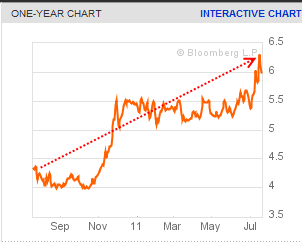
The Spanish 10 year bond has gone up by 50 percent only since September of 2010. This is the same kind of move we can see in the U.S. It can happen as quickly as a few months or a couple of years. The FHA insured loan market is going to change starting next month in California because of the conforming loan limit changes. This is a good thing. Incomes are not moving up so more affordable housing makes sense. Our society is obsessed with the “monthly nut” like a squirrel running out onto the highway to get food only to miss the big rig barreling down on it. We’ve seen this with families financing $2,000 televisions when they barely have enough for food. They just slap it on the credit card. From contacts in the housing industry many have told me that most that come to the table have very little saved up. They are barely qualifying for these mortgages and that is why the housing lobbyist are fighting tooth and nail trying to extend conforming loan limits even though they only impact maybe three or four states but are paid by all 50 state taxpayers.
When times were more normal
Even the boom and bust Los Angeles County market has seen more reasonable days not too long ago. In the mid-1990s home prices in the county were more reasonable:
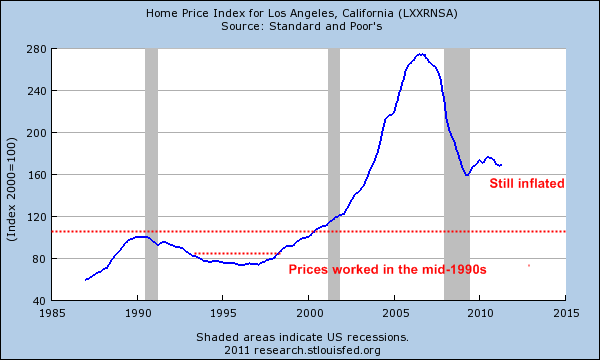
This occurred after the late 1980s and early 1990s bubble burst. Why did this work? First, home prices had a reasonable ratio in relation to household incomes. Take a look at the below:
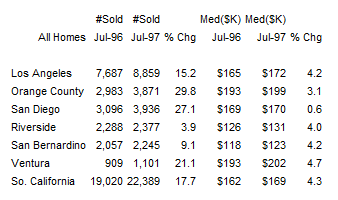
Source: Data Quick
The median home price for Los Angeles County was $165,000 in July of 1996. The median household income in 1996 was $43,500 putting the ratio at 3.7 which is still a bit high but definitely more reasonable. Today the median household income is $67,000 but the median L.A. County home is still selling for $318,000 (a ratio of 4.7). Even to get back to the more modest 3.7 figure of 1996, prices would need to fall down to $247,900 (an additional 20+ percent drop).
Keep in mind that throughout the 1990s the 30 year fixed rate mortgage had an average rate of roughly 7.5 percent (closer to the 8 percent historical long-term average). Today we are down to 4.5 percent but this is absolutely artificial and we are risking much larger things on a global scale than simply housing. It isn’t a question of whether rates will rise, but when. Will a Greece default trigger it? What about Spain? What about real estate bubbles in Canada or China popping? Risk is incredibly underpriced around the world at the moment and ironically the “riskless” investment seems to be with mortgages in the U.S. according to current mortgage rates. Hah! The mortgage backed securities that imploded markets in Iceland and all over the world are now seen as safe as U.S. Treasuries! In fact, the Fed has been making this exchange for years now with the bailouts.
What happens next?
The banking system is working through its shadow inventory but at a painfully slow pace. It is a race between market perception and the inevitable debt blowups around the world. Can banks off load more junk to the government (aka taxpayers) before the severe next correction hits? So far it has been working for banks but not for the American public. So what can we get for our example $549,000 figure? Let us see what we have in Culver City:
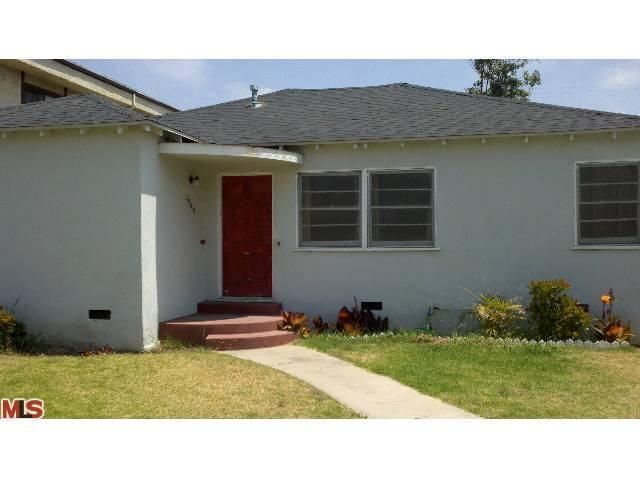
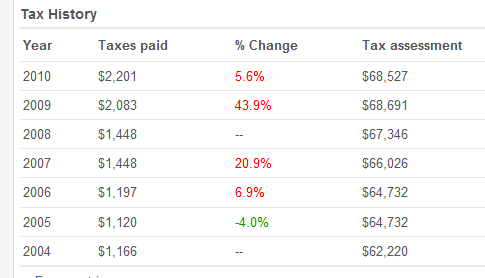
God bless Prop 13. The home is listed for $545,000 but is paying taxes at an assessed rate of $68,000. Let us look at the backyard here:

Now keep in mind what the logic would have been in the past to buy this home:
California is an odd sort of duck when it comes to the housing market. The market has dramatically collapsed in the Inland Empire and Central Valley with very little news coverage and many of these areas run similarities closer to what we are seeing in Las Vegas and Arizona.
Take for example Riverside County. Home prices peaked in June of 2006 with the median home price selling for $422,000. Today the median price is $200,000 down a jaw dropping 52 percent from the peak.
Let us now take Orange County. Orange County peaked in August of 2007 with a median price of $642,250 and today the median price is $445,000, a drop of 30 percent.
The argument I have made for California housing is not that every area is in a bubble (this was a case at the peak) but many specific markets still carry inflated values today in the summer of 2011. The only reason these prices remain this way is because of lax lending, Federal Reserve intervention, and banks holding large amounts of homes in what is known as the shadow inventory. We hear rumblings about the soon to expire conforming loan limits. This expiration will have little impact on say the county of Riverside but will be a significant change to Orange County. Let examine what a more “normal” market would look like.
Don’t get used to mortgage rates being this low

For over forty years the average 30 year fixed rate mortgage carried an interest rate of approximately 8 percent. Today that rate is down below 5 percent. There is only one reason for this; the Federal Reserve has bought trillions of dollars in mortgage backed securities shunned by the market and the global meltdown. There is an incredible underpricing of risk going on right now. The U.S. is still a flight to safety harbor but for how long given how our banks and politicians run things? The above chart reflects an unsustainable housing system for the United States. Mortgage rates are at rock bottom levels. I hear the argument going like, “rates have never been this low so you should buy!” Of course when home prices were going up it was, “don’t be priced out of the market!” Yet this mentality will only work if you think rates will remain low for a very long duration of time moving forward. Because what many potential California buyers will not tell you is that they are only buying their home as a starter home. There is no desire to stay put for 30 years. The name of the game is buy, build bubble equity, sell, and move into another bigger inflated place. Of course this model has severely imploded but the psychology is painfully resistant to adjust lower. Call it the Duesenberry demonstration effect.
First, let us run a scenario on a $549,000 home:

Many “starter” homes in places like Culver City will still cost this amount which is still insane. First, we will go with a 20 percent down payment of $109,800. This is only covering the down payment and not the additional closing costs to close out escrow but let us keep this simple. You would be financing a mortgage four times the size of a household income that would qualify for this property. You can buy a home at this price point if your household income pulls in $95,000. First, that income does not support a $549,000 home adequately and provides little buffer for mistakes but these are the kinds of transactions taking place today. After we factor in the monthly payment, $2,800 is coming out to pay your housing expenses each month. Now how much is a household making $95,000 a year taking in per month?

So basically for a starter home 50 percent of net pay is going to pay for housing expenses. This is insanity but you can actually qualify for this loan today if you went for it. But let us make a simple rational assumption. What if mortgage rates track back up to their historical four decade average? Let us run those numbers:

Now, you will notice that a household will magically need $30,000 more a year just to qualify. Plus, the monthly home payment jumps by $1,000 to $3,806. This is why the Federal Reserve is doing everything it can to keep mortgage rates artificially low even if it means imploding our economy with debt only a few years down the road. You have to ask why doesn’t the government just focus on increasing incomes since this will clearly push home values higher? After all, if the government is working with banks to artificially keep home prices up why not aim at artificially inflating incomes? Well first, the system is setup to hide shadow inventory and allow banks to push maximum leverage onto buyers and move them into over priced homes even though incomes have remained stagnant for over a decade! The only incomes that are not stagnant come from the financial industry. This is the madness here. Interest rates should go up with more true risk. Just look at Spain for example:

The Spanish 10 year bond has gone up by 50 percent only since September of 2010. This is the same kind of move we can see in the U.S. It can happen as quickly as a few months or a couple of years. The FHA insured loan market is going to change starting next month in California because of the conforming loan limit changes. This is a good thing. Incomes are not moving up so more affordable housing makes sense. Our society is obsessed with the “monthly nut” like a squirrel running out onto the highway to get food only to miss the big rig barreling down on it. We’ve seen this with families financing $2,000 televisions when they barely have enough for food. They just slap it on the credit card. From contacts in the housing industry many have told me that most that come to the table have very little saved up. They are barely qualifying for these mortgages and that is why the housing lobbyist are fighting tooth and nail trying to extend conforming loan limits even though they only impact maybe three or four states but are paid by all 50 state taxpayers.
When times were more normal
Even the boom and bust Los Angeles County market has seen more reasonable days not too long ago. In the mid-1990s home prices in the county were more reasonable:

This occurred after the late 1980s and early 1990s bubble burst. Why did this work? First, home prices had a reasonable ratio in relation to household incomes. Take a look at the below:

Source: Data Quick
The median home price for Los Angeles County was $165,000 in July of 1996. The median household income in 1996 was $43,500 putting the ratio at 3.7 which is still a bit high but definitely more reasonable. Today the median household income is $67,000 but the median L.A. County home is still selling for $318,000 (a ratio of 4.7). Even to get back to the more modest 3.7 figure of 1996, prices would need to fall down to $247,900 (an additional 20+ percent drop).
Keep in mind that throughout the 1990s the 30 year fixed rate mortgage had an average rate of roughly 7.5 percent (closer to the 8 percent historical long-term average). Today we are down to 4.5 percent but this is absolutely artificial and we are risking much larger things on a global scale than simply housing. It isn’t a question of whether rates will rise, but when. Will a Greece default trigger it? What about Spain? What about real estate bubbles in Canada or China popping? Risk is incredibly underpriced around the world at the moment and ironically the “riskless” investment seems to be with mortgages in the U.S. according to current mortgage rates. Hah! The mortgage backed securities that imploded markets in Iceland and all over the world are now seen as safe as U.S. Treasuries! In fact, the Fed has been making this exchange for years now with the bailouts.
What happens next?
The banking system is working through its shadow inventory but at a painfully slow pace. It is a race between market perception and the inevitable debt blowups around the world. Can banks off load more junk to the government (aka taxpayers) before the severe next correction hits? So far it has been working for banks but not for the American public. So what can we get for our example $549,000 figure? Let us see what we have in Culver City:

3944 TILDEN AVE, Culver City, CA 90232This is your starter home. 2 bedrooms and 1 bath listed at 1,029 square feet. The listing price on this home is $545,900. Looking at tax assessment records this place was purchased in more sensible times:
Listed 06/17/11
Beds 2
Full Baths 1
Partial Baths 0
Property Type SFR
Sq. Ft. 1,029
$/Sq. Ft. $531
Lot Size 6,991 Sq. Ft.
Year Built 1941

God bless Prop 13. The home is listed for $545,000 but is paying taxes at an assessed rate of $68,000. Let us look at the backyard here:

Now keep in mind what the logic would have been in the past to buy this home:
A- Okay, we buy this place and stick it out for two or three years.This is seriously how people think in Southern California in many of these bubble markets. Yet rates will go up and are you willing to stay put in the above place for 10, 20, or even 30 years? That is the reality but that is now what is being pitched by those in the housing industry. Either way, there is absolutely no evidence suggesting we will see solid appreciation in these markets for years to come.
B- By that time, we will find $100,000 to $150,000 in appreciation and we move to home #2
C- Three years pass and buy $700,000 to $750,000 home and if things go well, rinse and repeat
No comments:
Post a Comment